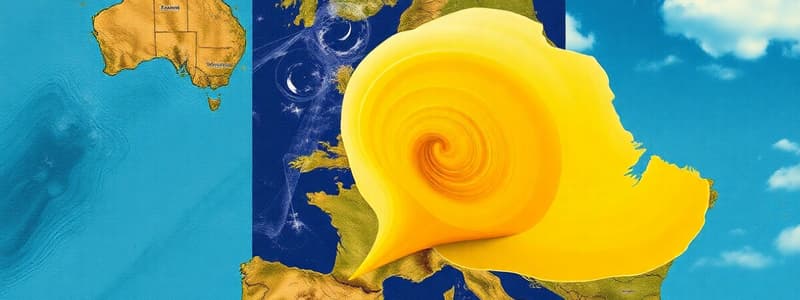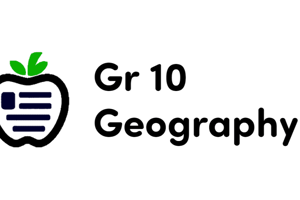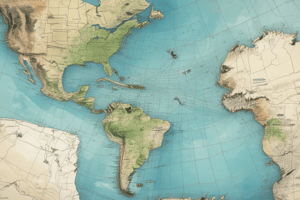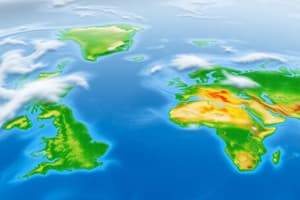Podcast
Questions and Answers
Which weather condition is typically associated with a high-pressure system?
Which weather condition is typically associated with a high-pressure system?
- Dense fog and low visibility
- Strong winds and rapidly changing temperatures
- Stable weather and clear skies (correct)
- Heavy precipitation and thunderstorms
What does a wind barb with one full line and one pennant indicate?
What does a wind barb with one full line and one pennant indicate?
- Wind speed of 9-14 miles per hour
- Calm conditions with no wind
- Light breeze with variable direction
- Wind speed of 55-60 miles per hour (correct)
Why are weather maps and symbols essential tools in meteorology?
Why are weather maps and symbols essential tools in meteorology?
- They are primarily used for historical weather analysis, not current forecasting.
- They provide a concise visual representation of extensive weather data, facilitating analysis and forecasting. (correct)
- They simplify weather patterns to be understood by the general public only.
- They eliminate the need for meteorologists.
How does the spacing of isobars on a weather map relate to the pressure gradient and wind conditions?
How does the spacing of isobars on a weather map relate to the pressure gradient and wind conditions?
What weather change is most likely to occur after the passage of a cold front?
What weather change is most likely to occur after the passage of a cold front?
Which of the following factors is most likely to affect the accuracy of weather forecasting?
Which of the following factors is most likely to affect the accuracy of weather forecasting?
On a station model, what do asterisk symbols and three horizontal lines typically represent, respectively?
On a station model, what do asterisk symbols and three horizontal lines typically represent, respectively?
In a station model, how is wind speed typically indicated?
In a station model, how is wind speed typically indicated?
What does the shaded circle at the center of a station model primarily represent?
What does the shaded circle at the center of a station model primarily represent?
If a station model shows current weather conditions to the left as snowflakes, which of the following is most likely happening at that location?
If a station model shows current weather conditions to the left as snowflakes, which of the following is most likely happening at that location?
Flashcards
Weather Map
Weather Map
A map displaying weather information in a condensed format.
Meteorology
Meteorology
A branch of science focused on studying Earth's atmosphere and weather.
Meteorologist
Meteorologist
A scientist who studies Earth's atmosphere to predict the weather.
Weather Forecasting
Weather Forecasting
Signup and view all the flashcards
Station Model
Station Model
Signup and view all the flashcards
Wind Barb
Wind Barb
Signup and view all the flashcards
Cold Front
Cold Front
Signup and view all the flashcards
Warm Front
Warm Front
Signup and view all the flashcards
Isobar
Isobar
Signup and view all the flashcards
Low-Pressure System
Low-Pressure System
Signup and view all the flashcards
Study Notes
- Weather maps present large amounts of weather data in a simplified format.
- Meteorologists use weather maps to forecast and display current and future weather conditions.
- Weather maps use specific symbols to represent weather events and their characteristics.
Analyzing Weather with Weather Symbols
- Meteorology studies Earth's atmosphere and weather.
- Meteorologists analyze atmospheric conditions to make weather predictions, known as forecasting.
- Forecasting involves analyzing radar and satellite data.
- Weather conditions like temperature and visibility can impact forecasting accuracy.
- Weather station model symbols are used to display weather information derived from forecasts.
How to Read a Station Model
- A station model illustrates the weather at a specific location and time, usually at a weather station.
- Station models present temperature, wind speed, cloud cover, precipitation, and atmospheric pressure in one location.
- The current temperature is on the top left of the station model.
- The central symbol in a station model represents the wind speed and direction and cloud coverage.
- A symbol to the left of the station model displays current weather conditions like rain or snow.
- Wind barbs with lines designate wind speeds, while shaded circles designate amount of cloud coverage.
Cloud Cover and Wind Direction Symbols
- Cloud cover symbols in a station model use a tenths system.
- Shaded circles indicate cloud coverage.
- A half-shaded circle represents five tenths cloud coverage.
- Wind direction is shown by wind barbs: straight lines with lines or pennants signifying wind speed.
- One line on a wind barb indicates a wind speed of approximately 9-14 miles per hour.
- One pennant on a wind barb indicates a wind speed of 55-60 miles per hour.
- Wind direction is indicated by the direction the wind barb points.
Other Meteorological Symbols
- Isobars show areas of air pressure.
- Capital letters "H" and "L" indicate areas of high and low pressure.
- Weather fronts are displayed as colored lines with different symbols.
High-Pressure and Low-Pressure Systems
- High pressure system: An area with higher air pressure than its surroundings.
- High pressure systems bring stable weather and clear skies, moving from the northwest to southeast.
- A capital letter "H" symbolizes a high pressure system on a weather map.
- Low pressure system: An area where the center has a lower air pressure than its surroundings.
- Low pressure systems bring precipitation and cloudy skies, moving from southwest to northeast.
- A capital letter "L" indicates areas of low pressure systems on a weather map.
Cold Fronts and Warm Fronts
- Cold front: Occurs when a cold air mass meets and replaces a warm air mass, causing temperature drops.
- A blue line with triangles indicates a cold front on a weather map.
- Warm front: Occurs when a warm air mass meets and replaces a cold air mass, bringing warmer, more humid weather.
- A red line with half circles indicates a warm front on a weather map.
- Stationary Front: Occurs when a warm or cold front stops moving
- Occluded front: Can form if a cold front moves ahead of a warm front
Isobars
- Isobar: A circle enclosing an area of specific air pressure.
- Closely spaced isobars indicate a significant and quick difference in air pressure.
- Widely spaced isobars indicate a gradual change in air pressure.
Weather, Cloud Type, and Numbers
- Asterisks symbolize snow.
- Three horizontal lines signify fog.
- A half-circle image symbolizes low cumulus clouds
- A triangle with one missing side symbolizes thin altostratus clouds
Studying That Suits You
Use AI to generate personalized quizzes and flashcards to suit your learning preferences.




